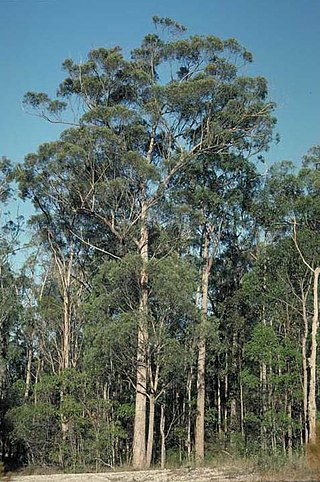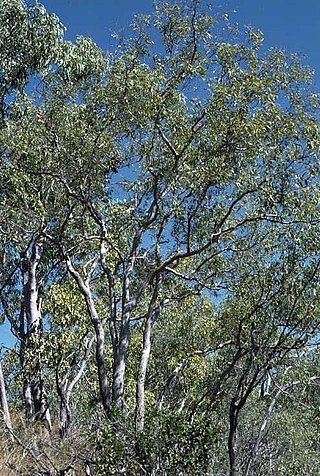
Eucalyptus punctata, commonly known as grey gum, is a small to medium-sized tree that is endemic to eastern Australia. It has smooth grey bark that is shed in patches, lance-shaped, curved or egg-shaped adult leaves flower buds in groups of seven, white flowers and hemispherical or cup-shaped fruit. Its leaves are one of the favoured foods of the koala.

Corymbia intermedia, commonly known as pink bloodwood, is a species of medium to tall tree that is endemic to north-eastern Australia. It has rough, tessellated bark on the trunk and branches, flower buds in groups of seven, white flowers and oval to barrel-shaped fruit.

Corymbia polycarpa, also known as long-fruited bloodwood or small-flowered bloodwood, is a species of tree that is endemic to northern Australia. Indigenous Australians of different language groups have different names for the tree. The Nungali peoples know the tree as narrga or gunjid, the Mulluk-Mulluk know it as dawart, the Yangman know it as bodog, the Gurindji peoples as jadburru and the Wagiman as jagatjjin. It is a medium-sized tree with rough, tessellated bark on the trunk and branches, lance-shaped to curved adult leaves, flower buds in groups of seven or nine, white or cream-coloured flowers and barrel-shaped fruit.

Eucalyptus acmenoides, commonly known as white mahogany or barayly, is a tree that is endemic to eastern Australia. It is a large tree with grey to reddish brown, stringy bark, lance-shaped leaves, oval to spindle-shaped buds and more or less hemispherical fruits. The two sides of adult leaves are very different shades of green.

Corymbia terminalis, also known as tjuta, joolta, bloodwood, desert bloodwood, plains bloodwood, northern bloodwood, western bloodwood or inland bloodwood, is a species of small to medium-sized tree, rarely a mallee that is endemic to Australia. It has rough, tessellated bark on some or all of the trunk, sometimes also on the larger branches, smooth white to cream-coloured bark above, lance-shaped adult leaves, flower buds in groups of seven, white flowers and urn-shaped fruit.

Eucalyptus phoenicea , commonly known as scarlet gum or gnaingar or ngainggar, is a tree of the family Myrtaceae from Northern Australia.

Eucalyptus apothalassica is a tree native to New South Wales in eastern Australia. Common names for the species include inland white mahogany.

Eucalyptus psammitica, commonly known as bastard white mahogany, is a species of small to medium-sized tree that is endemic to eastern Australia. It has rough, stringy or fibrous, prickly bark on the trunk and branches, lance-shaped to curved adult leaves, flower buds in groups of between seven and eleven, white flowers and cup-shaped to hemispherical fruit.
Eucalyptus tortilis is a species of mallet and a gimlet that is endemic to the southwest of Western Australia. It has smooth bark, lance-shaped adult leaves, flower buds in groups of seven, creamy white flowers and hemispherical to cup-shaped fruit.
Corymbia candida, commonly known as desert ghost gum or ghost gum, is a bloodwood native to arid parts of the Northern Territory and Western Australia.

Corymbia erythrophloia, commonly known as red bloodwood, variable-barked bloodwood, red-barked bloodwood or gum-topped bloodwood, is a species of tree that is endemic to Queensland. It has rough bark on the trunk and branches, egg-shaped or lance-shaped adult leaves, flower buds in groups of seven, creamy white flowers and urn-shaped to spherical fruit.

Corymbia clarksoniana, commonly known as Clarkson's bloodwood or grey bloodwood, is a species of medium-sized tree that is native to Queensland and northern New South Wales. It has rough, tessellated greyish to brownish bark on the trunk and branches, lance-shaped, glossy green leaves that are paler on the lower surface, flower buds in groups of seven, white flowers and urn-shaped to barrel-shaped fruit.

Eucalyptus carnea, known as the thick-leaved mahogany or broad-leaved white mahogany, is a species of tree that is endemic to coastal areas of eastern Australia. It has rough, stringy bark from the trunk to the thinnest branches, lance-shaped or curved adult leaves, flower buds in groups of between seven and eleven, white flowers and cup-shaped to hemispherical fruit.
Corymbia ellipsoidea is a species of tree that is endemic to Queensland. It has rough bark on the trunk and larger branches, lance-shaped adult leaves, flower buds usually in groups of seven, creamy white flowers and barrel-shaped to urn-shaped fruit.

Corymbia jacobsiana, commonly known as Jacob's bloodwood or stringybark bloodwood, is a species of tree that is endemic to the Northern Territory. It has rough, stringy bark on the trunk and branches, lance-shaped to elliptical or curved adult leaves, flower buds in groups of three or seven, creamy white flowers and urn-shaped fruit.

Corymbia leichhardtii, commonly known as rustyjacket, Leichhardt's rustyjacket, or yellow jacket, is a species of tree that is endemic to Queensland. It has rough, tessellated bark on the trunk and branches, lance-shaped or curved adult leaves, flower buds in groups of seven, white flowers and barrel-shaped, urn-shaped or shortened spherical fruit.

Eucalyptus helidonica is a species of tree that is endemic to an area near Helidon in Queensland. It has rough, finely fibrous bark, lance-shaped or curved adult leaves that are paler on the lower surface, flower buds in groups of eleven or more, white flowers and shortened spherical or barrel-shaped fruit.
Eucalyptus latisinensis, commonly known as white mahogany, is a species of tree that is endemic to Queensland. It has rough, fibrous to stringy bark, lance-shaped to curved adult leaves, flower buds in groups of seven to eleven or more, white flowers and shortened spherical to hemispherical fruit.

Eucalyptus similis, commonly known as the inland yellowjacket or the Queensland yellowjacket, is a eucalypt that is native to Queensland.
Eucalyptus moderata, also known as redwood mallee, is a species of tree or a mallee that is endemic to the southwest of Western Australia. It has rough, hard, fibrous bark on some or all of the trunk, lance-shaped adult leaves, flower buds usually in groups of seven, pale yellow flowers and pendulous, urn-shaped fruit.















